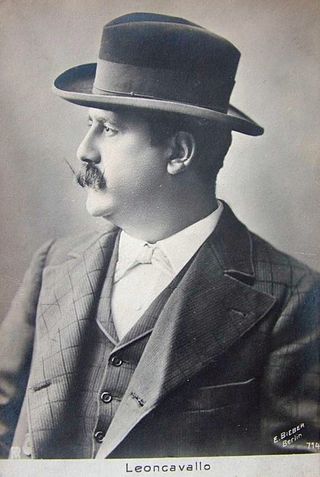
Ruggero Leoncavallo was an Italian opera composer and librettist. Although he produced numerous operas and other songs throughout his career it is his opera Pagliacci (1892) that remained his lasting contribution, despite attempts to escape the shadow of his greatest success.

The Teatro Massimo Vittorio Emanuele is an opera house and opera company located on the Piazza Verdi in Palermo, Sicily. It was dedicated to King Victor Emanuel II. It is the biggest in Italy, and one of the largest of Europe, renowned for its perfect acoustics.
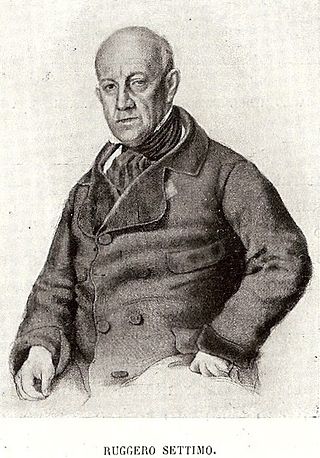
Ruggero Settimo was an Italian politician, diplomat, and patriotic activist from Sicily. He was a counter-admiral of the Sicilian Fleet. He fought alongside the British fleet in the Mediterranean Sea against the French under Napoleon Bonaparte. He reconquered the island of Malta, and defended the city of Gaeta near Naples.
Maurizio Colasanti is an Italian conductor.

Salvatore Greco is an Italian violinist, leader of the Orchestra of Teatro Massimo, Palermo since 1991.
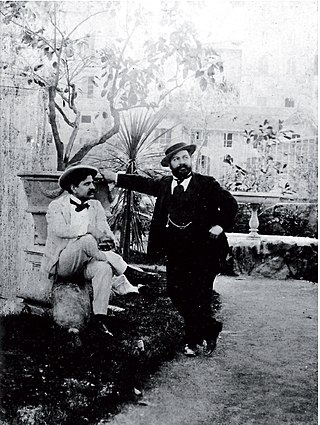
Mario Rutelli was an Italian sculptor.

Gino Marinuzzi was an Italian conductor and composer, particularly associated with the operas of Wagner and the Italian repertory.

Alessandro Siciliani is an Italian conductor of opera and symphonic music. He is also a composer of symphonic music. Siciliani was born in Florence, Italy, the son of Ambra and Francesco Siciliani, the celebrated opera impresario. Siciliani currently resides in Columbus, Ohio, where he was the music director of the Columbus Symphony Orchestra from 1992 to 2004.
Johannes Wildner is an Austrian conductor, conducting professor, and former member violinist with the Vienna Philharmonic.
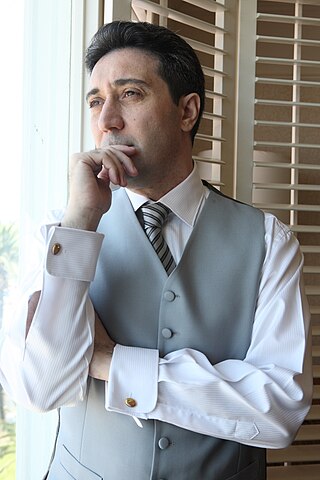
Salvatore Di Vittorio is an Italian composer and conductor. He is music director and Conductor of the Chamber Orchestra of New York. He has been recognized by Luigi Verdi as a "lyrical musical spirit, respectful of the ancient Italian tradition… an emerging leading interpreter of the music of Ottorino Respighi".
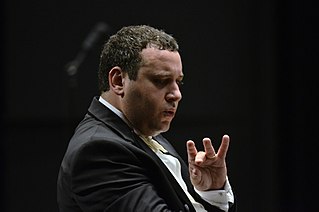
Antonino Fogliani is an Italian conductor.
Gemma Bosini was an Italian operatic soprano who had an active international performance career in 1909–1930. She is especially associated with the role of Alice Ford in Giuseppe Verdi's Falstaff, a role which she performed more than 400 times on stage during her career. She is also remembered for being the first soprano to record the role of Mimi in Giacomo Puccini's La boheme in 1917. She also made complete recordings of Gounod's Faust and Lehar's The Merry Widow. After retiring from performance in 1930, she devoted herself to teaching singing and managing the career of her husband, baritone Mariano Stabile.

San Domenico is a Baroque-style Roman Catholic church, located on Piazza San Domenico, and located in the ancient quarter of La Loggia, in central Palermo, region of Sicily, Italy. Piazza San Domenico opens to Via Roma a few blocks south of the large Palazzo delle Poste, and a few blocks north of Sant'Antonio Abate and Teatro Biondo, is the northern border of the warren of alleys of the Vucciria neighborhood. The church houses the burial monuments of many notable Sicilians, and is known thus as the Pantheon of illustrious Sicilians.

The Biondo Theatre is a neoclassical and Art Nouveau-style theater building located on Via Roma #258, corner with Via Venezia, in the ancient quarter of Castellamare of central Palermo, region of Sicily, Italy. Diagonally across Via Roma is the ancient church of Sant'Antonio Abate and a stairwell descending into the warrens of the Vucciria Market.

The Modern Art Gallery of Palermo is a civic art gallery of Palermo, displaying works from the 19th until the early 20th century, located on Via Sant'Anna #21, adjacent to the church of Sant'Anna la Misericordia in the ancient quarter of the Kalsa of the city of Palermo, region of Sicily, Italy. The collections were moved to this site, consisting of the former Franciscan convent associated with Sant'Anna and the adjacent Palazzo Bonet.

Piazza Ruggero Settimo is a square of Palermo. Along with the contiguous Piazza Castelnuovo, it forms a single urban space, commonly called Piazza Politeama, by virtue of the presence of Teatro Politeama, the second most important theatre of the city after Teatro Massimo. The square is located between Via Ruggero Settimo and Viale della Libertà, near the historic centre of Palermo, and represents one of the most popular city's square.

Piazza Castelnuovo is a square of Palermo. Along with the contiguous Piazza Ruggero Settimo, it forms a single urban space, commonly called Piazza Politeama, by virtue of the presence of Teatro Politeama, the second most important theatre of the city after Teatro Massimo. The square is located between Via Ruggero Settimo, Viale della Libertà and Via Dante, near the historic centre of Palermo, and represents one of the most popular city's square.

The following outline is provided as an overview of and topical guide to Palermo:

Benedetto Civiletti was an Italian sculptor, active mainly in his native Sicily. He is known for his Romantic-style public sculptures on allegorical, genre, or historical themes.
Gianluca Martinenghi is an Italian opera and symphonic music conductor. From 2016 to 2018 he was the Music director of Macedonian National Theatre. Currently he is the Artistic Secretary of Teatro Reggio in Turin, Italy,

























